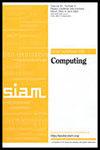有限制树宽的诱导子图和容器法
IF 1.6
3区 计算机科学
Q3 COMPUTER SCIENCE, THEORY & METHODS
引用次数: 0
摘要
SIAM 计算期刊》,第 53 卷第 3 期,第 624-647 页,2024 年 6 月。 摘要图中的洞是长度至少为 4 的诱导循环。如果一个洞的长度至少为 5,那么它就是长洞。我们用 [math] 表示 [math] 顶点上的路径。本文给出了以下问题的多项式时间算法:无长洞图中的最大权重独立集问题和无[math]图中的反馈顶点集问题。上述每个结果都解决了一个相应的长期未决问题。一个扩展的[math]是一个五顶点洞,它有一个额外的顶点与洞的一个或两个连续顶点相邻。让[math]成为一类不包含扩展[math]和长度至少为 6 的洞的诱导子图;[math]包含所有无长洞图和所有无[math]图。我们证明,给定一个有顶点权重的[math]顶点图[math]和一个整数[math],我们可以及时[math]找到一个树宽小于[math]的[math]的最大权重诱导子图。这意味着上述两个结果。为了实现这一目标,我们将潜在最大簇(PMC)框架扩展到了容器。这个框架由 Bouchitté 和 Todinca [SIAM J. Comput., 31 (2001), pp.进一步的发展是在此框架内解决最大权重独立集问题(例如,针对无[math]图[Lokshtanov, Vatshelle, and Villanger, SODA 2014, pp.570-581] 或无[math]图[Grzesik, Klimošová, Pilipczuk, and Pilipczuk, ACM Trans.Algorithms, 18 (2022), pp.在上述所有著作中,最后一步都涉及动态编程算法,其状态空间基于所考虑的 PMC 列表。在这里,我们修改了动态编程算法,并证明只需考虑每个 PMC 的一个容器即可:一个最大小群的超集,该小群仅在 PMC 的顶点上与所寻求的解决方案相交。对框架的这一强化不仅使我们获得了主要结果,还大大简化了之前论文中的推理。本文章由计算机程序翻译,如有差异,请以英文原文为准。
Induced Subgraphs of Bounded Treewidth and the Container Method
SIAM Journal on Computing, Volume 53, Issue 3, Page 624-647, June 2024.
Abstract. A hole in a graph is an induced cycle of length at least 4. A hole is long if its length is at least 5. By [math], we denote a path on [math] vertices. In this paper, we give polynomial-time algorithms for the following problems: the maximum weight independent set problem in long-hole–free graphs and the feedback vertex set problem in [math]-free graphs. Each of the above results resolves a corresponding long-standing open problem. An extended [math] is a five-vertex hole with an additional vertex adjacent to one or two consecutive vertices of the hole. Let [math] be the class of graphs excluding an extended [math] and holes of length at least 6 as induced subgraphs; [math] contains all long-hole–free graphs and all [math]-free graphs. We show that, given an [math]-vertex graph [math] with vertex weights and an integer [math], one can, in time, [math] find a maximum-weight induced subgraph of [math] of treewidth less than [math]. This implies both aforementioned results. To achieve this goal, we extend the framework of potential maximal cliques (PMCs) to containers. Developed by Bouchitté and Todinca [SIAM J. Comput., 31 (2001), pp. 212–232] and extended by Fomin, Todinca, and Villanger [SIAM J. Comput., 44 (2015), pp. 54–87], this framework allows us to solve a wide variety of tasks, including finding a maximum-weight induced subgraph of treewidth less than [math] for fixed [math], in time polynomial in the size of the graph and the number of potential maximal cliques. Further developments, tailored to solve the maximum weight independent set problem within this framework (e.g., for [math]-free [Lokshtanov, Vatshelle, and Villanger, SODA 2014, pp. 570–581] or [math]-free graphs [Grzesik, Klimošová, Pilipczuk, and Pilipczuk, ACM Trans. Algorithms, 18 (2022), pp. 4:1–4:57]), enumerate only a specifically chosen subset of all PMCs of a graph. In all aforementioned works, the final step is an involved dynamic programming algorithm whose state space is based on the considered list of PMCs. Here, we modify the dynamic programming algorithm and show that it is sufficient to consider only a container for each PMC: a superset of the maximal clique that intersects the sought solution only in the vertices of the PMC. This strengthening of the framework not only allows us to obtain our main result but also leads to significant simplifications of the reasoning in previous papers.
Abstract. A hole in a graph is an induced cycle of length at least 4. A hole is long if its length is at least 5. By [math], we denote a path on [math] vertices. In this paper, we give polynomial-time algorithms for the following problems: the maximum weight independent set problem in long-hole–free graphs and the feedback vertex set problem in [math]-free graphs. Each of the above results resolves a corresponding long-standing open problem. An extended [math] is a five-vertex hole with an additional vertex adjacent to one or two consecutive vertices of the hole. Let [math] be the class of graphs excluding an extended [math] and holes of length at least 6 as induced subgraphs; [math] contains all long-hole–free graphs and all [math]-free graphs. We show that, given an [math]-vertex graph [math] with vertex weights and an integer [math], one can, in time, [math] find a maximum-weight induced subgraph of [math] of treewidth less than [math]. This implies both aforementioned results. To achieve this goal, we extend the framework of potential maximal cliques (PMCs) to containers. Developed by Bouchitté and Todinca [SIAM J. Comput., 31 (2001), pp. 212–232] and extended by Fomin, Todinca, and Villanger [SIAM J. Comput., 44 (2015), pp. 54–87], this framework allows us to solve a wide variety of tasks, including finding a maximum-weight induced subgraph of treewidth less than [math] for fixed [math], in time polynomial in the size of the graph and the number of potential maximal cliques. Further developments, tailored to solve the maximum weight independent set problem within this framework (e.g., for [math]-free [Lokshtanov, Vatshelle, and Villanger, SODA 2014, pp. 570–581] or [math]-free graphs [Grzesik, Klimošová, Pilipczuk, and Pilipczuk, ACM Trans. Algorithms, 18 (2022), pp. 4:1–4:57]), enumerate only a specifically chosen subset of all PMCs of a graph. In all aforementioned works, the final step is an involved dynamic programming algorithm whose state space is based on the considered list of PMCs. Here, we modify the dynamic programming algorithm and show that it is sufficient to consider only a container for each PMC: a superset of the maximal clique that intersects the sought solution only in the vertices of the PMC. This strengthening of the framework not only allows us to obtain our main result but also leads to significant simplifications of the reasoning in previous papers.
求助全文
通过发布文献求助,成功后即可免费获取论文全文。
去求助
来源期刊

SIAM Journal on Computing
工程技术-计算机:理论方法
CiteScore
4.60
自引率
0.00%
发文量
68
审稿时长
6-12 weeks
期刊介绍:
The SIAM Journal on Computing aims to provide coverage of the most significant work going on in the mathematical and formal aspects of computer science and nonnumerical computing. Submissions must be clearly written and make a significant technical contribution. Topics include but are not limited to analysis and design of algorithms, algorithmic game theory, data structures, computational complexity, computational algebra, computational aspects of combinatorics and graph theory, computational biology, computational geometry, computational robotics, the mathematical aspects of programming languages, artificial intelligence, computational learning, databases, information retrieval, cryptography, networks, distributed computing, parallel algorithms, and computer architecture.
 求助内容:
求助内容: 应助结果提醒方式:
应助结果提醒方式:


